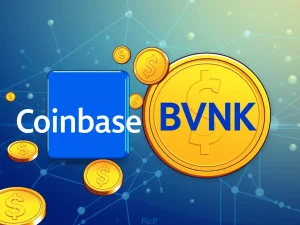Stablecoin Revolution: Banks Embrace This Powerful Tech

The financial world is witnessing a remarkable transformation. For years, many traditional banks actively avoided businesses involved in crypto, a practice often referred to as ‘debanking’. However, a significant pivot is underway. Banks are now exploring how to upgrade their payments infrastructure using stablecoins, viewing them as a crucial next step for payment innovation. This dramatic shift highlights the growing influence of digital assets and the increasing need for banks to adapt to stay competitive in the evolving landscape of banking and finance.
From Debanking to Embracing Stablecoins
It’s hard to find many historical examples of such a rapid and complete change in approach within an industry. Just a few years ago, crypto startup founders and companies holding crypto assets faced immense challenges in securing and maintaining bank accounts. Debanking was a common hurdle, with major institutions often reluctant to engage with the crypto sector.
This stance is changing. Regulatory environments are evolving, with previous policies that were seen as discriminatory towards the crypto industry being reconsidered or repealed. This newfound openness is making it possible for the finance sector to seriously consider blockchain technology and assets like stablecoins.
Understanding the Power of Stablecoins for Payments
While large institutions have experimented with digital currencies on private blockchains for internal functions like treasury reconciliation, the true potential lies in stablecoins operating on public networks. These experiments were limited, missing the core innovation that public networks offer.
The use case for stablecoins in international remittances is clear due to their speed and cost-efficiency. However, we are only beginning to see the broader applications. For instance, stablecoins can fundamentally change payments processing:
- They can help eliminate unauthorized payment disputes.
- They enable significantly faster payment cycles compared to traditional systems.
- Their programmability can streamline complex processes like payroll, which currently involves numerous disparate systems (ACH, wires, various file formats).
This programmability allows companies to build greater efficiency into their payment workflows, improving processing times and reconciliation.
Increased Stablecoin Adoption and Regulatory Landscape
Data indicates a clear trend of increasing stablecoin adoption. Active stablecoin wallets have grown substantially, demonstrating wider usage. This growth is supported by improvements in stablecoin infrastructure and increasing confidence in their security and stability. The vast majority of stablecoins are now fiat-backed, with riskier algorithmic models falling out of favor.
Regulatory clarity is also progressing. Jurisdictions like Wyoming have passed specific stablecoin legislation, and discussions around federal regulation are ongoing. This regulatory movement provides a clearer framework for institutions to engage with stablecoins.
Furthermore, incremental technological changes are making stablecoins more accessible for non-crypto businesses. User experience problems are being addressed, simplifying integration into existing business operations. As more assets become tokenized onchain, using stablecoins on public networks prepares companies for the future financial system.
Examples of Banks Embracing Stablecoin Technology
Smaller banks are recognizing the opportunity to incorporate permissionless, public network stablecoins into their services. Custodia Bank, for example, has issued its own stablecoin, Avit, on Ethereum. This allows Custodia’s users access to quick, cost-effective banking services, setting a precedent for other financial institutions.
It’s not just stablecoins driving this change. The broader movement towards asset tokenization is gaining traction, with prominent figures in finance advocating for the tokenization of traditional assets like bonds and stocks. For banks seeking a competitive edge against powerful fintechs, navigating shifting interest rates, and addressing lower consumer savings, leveraging stablecoins to improve products and internal operations could be a critical strategic decision.
The Future of Banking and Payments
The rapid evolution from shunning crypto businesses to actively exploring stablecoins represents a significant turning point for the banking sector. Stablecoins offer tangible benefits in speed, efficiency, and programmability that traditional payments systems struggle to match. As stablecoin adoption continues to grow and regulatory frameworks mature, the integration of this powerful technology into mainstream finance seems increasingly inevitable. Banks that proactively embrace stablecoins and the broader potential of blockchain technology are better positioned to thrive in the competitive landscape of modern finance.







